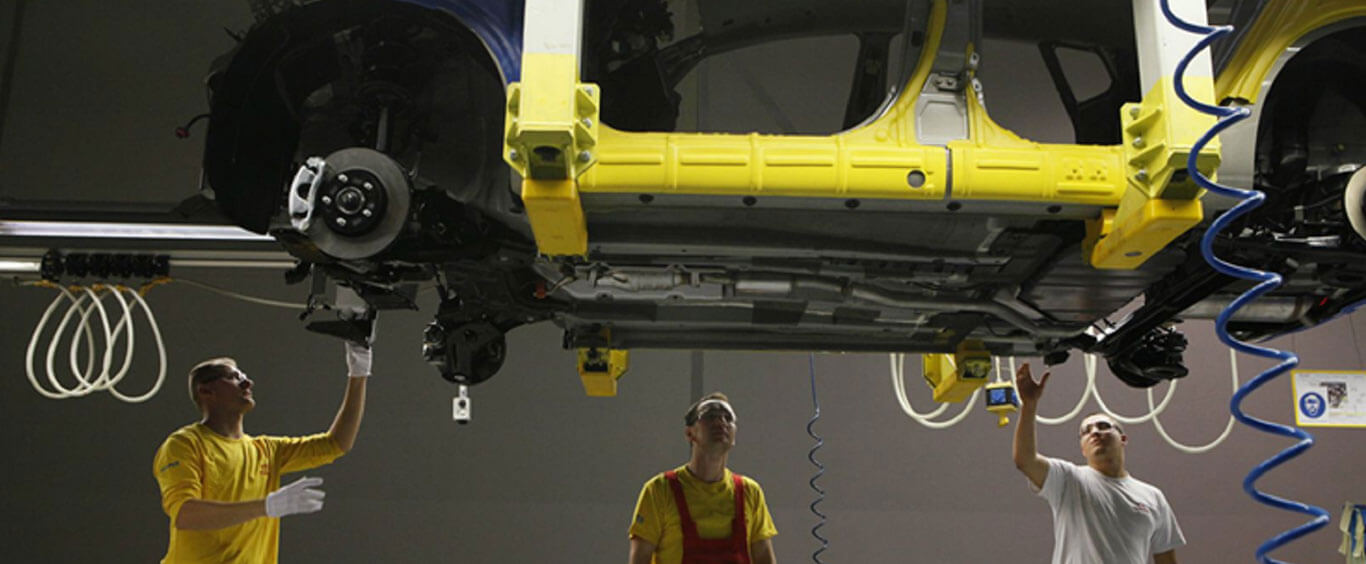
Would you like to start a conversation with other industry leaders to brainstorm a challenge or to just know more on a particular topic?
Engage in online discussions with your Peers
Start Now
"The opening up of new markets, foreign or domestic, and the organizational development from the craft shop to such concerns as U.S. Steel illustrate the same process of industrial mutation—if I may use that biological term—that incessantly revolutionizes the economic structure from within, incessantly destroying the old one, incessantly creating a new one. This process of “Creative Destruction” is the essential fact about capitalism."
— Joseph Schumpeter
Two decades ago when American Express decided to offshore processes to India, first from Japan, Asia Pacific and Australia markets and then from other parts of the globe, it was a silent disruption. Forever, it changed the way processes are centralized or consolidated. Thanks to such globalization and technology advancements, the business environment world has undergone a sea-change over the last 20 years. The internet explosion made the world smaller and more intertwined.
As Peter Drucker predicted, the 21st century brought larger focus on knowledge worker, dealing with processes, exceptions, optimization and transformation. Automation is replacing routine or manual work. Organizations accept increasing number of employees working from home, performing multiple tasks, connected by technology, the Internet and cell phones. ‘Chains’ have given way for ‘networks’ connecting small and big with equal importance and value. Apps connecting free lancers and making them part of a networked business is becoming a way of life.
The New World
The market and technology is continuously changing thus decreasing the lifetime of products and competitive advantages. The businesses are required to rapidly adapt to changes in demand and business disruptions. The business environment is increasingly emphasising on four key aspects of change required for sustainable growth – the VUCA world gives way to a new action oriented one called the AIDE world – Agility, Innovation, Disruption and Excellence.
AIDE… creating a revolution in the way ‘change’ is initiated or dealt with by organizations i.e. changing the very process of change management!
Today, instead of embedding these principles into the business ethos, they are fast becoming jargons in every day conversations of business circles. In fact, these terms are creating a revolution in the way ‘change’ is initiated or dealt with by organizations i.e. changing the very process of change management! Hence, it is imperative to have a rethink on how the process of change itself is impacted and what actions are required to achieve sustainable growth.
The key difference in the way we are approaching managing in turbulent times is Situation vs. Response. VUCA is a situation that exists as a constant in today’s ‘external’ environment, beyond one’s own business.
However, organizations will benefit to focus on what the business can actually do ‘internally’ to respond to this situation and tackle this ever changing environment. VUCA is focused on external Situation while AIDE is focused on Response from within, in a way, your AIDE in this VUCA world!
Agility
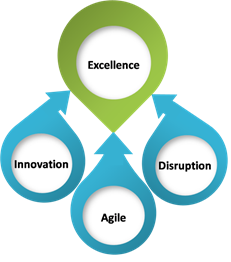 Agility is the best foundation for the AIDE world and the best start point in today’s business environment to lead and manage change.
Agility is the best foundation for the AIDE world and the best start point in today’s business environment to lead and manage change.
Agility is very often associated with software development, given the extensive use of ‘Agile’ methodology of software development.
Fundamentally, the Agile movement, as it is called, substitutes traditional sequential development with iterative & adaptive development to ensure rapid delivery.
However, despite the proven value of Agile, one of the major reasons for the limited success of this methodology has been due to the limited change brought about in the mind sets of developers and software engineers, and quite often, the processes followed are also not strictly in line with the demands of this flexible methodology. Having said, agility is not an exclusive term applicable only for technologies. It applies very much to people and processes too, besides of course, to the business itself. However, in today’s business environment this is not getting its due attention, and hence, the overall process of agility suffers.
As per a study conducted by McKinsey in 2015, rethinking change for developing business agility is not just about getting the technology people ‘trained’ on agile, but much more, as under:
- Ensuring a culture of agility in the minds of all people in the organization tuned to adaptability and flexibility
- Frequent cross-functional, cross-unit dialogue and collaboration
- Flexibility to live with the reality of clarity and chaos, and passing on lesser ambiguity to the teams based on areas of control.
The Genius of ‘AND’
Jim Collins first coined this phrase – the tyranny of the OR and the genius of AND in Built to Last, focused on what makes companies to succeed year after year. In his book, he describes how choosing between ‘seemingly; contradictory concepts—focusing on this or that—leads to missed opportunities. Is the product low cost or high quality? Do I focus on short-term opportunities or long-term strategy? Should the company be bold or conservative? Collins discovered that the best companies find a way to embrace the positive aspects of both sides of a dichotomy, and instead of choosing, they find a way to have both or make them co-exist.
This paradigm is true for agility as well, where organizations, paradoxically, learn to be both stable (resilient, reliable and efficient) and dynamic (fast, nimble and adaptive). The rethinking change in AIDE world requires companies to become more agile by designing their organizations both to drive speed and create stability. To enable this coexistence, companies focus on three areas viz., organizational structures which define how resources are distributed, governance which guides how decisions are made and processes which determine how things get done.
In Business Services, agility cuts across process, operations and business. The ‘exceptional way to handle exceptions’ is clearly process agility; the ability to manage peaks, troughs, scalable at short notice, month ends with minimal extra effort, virtual close, actionable dashboards etc., demonstrates operational agility; and the ability to scale up (or down) front office or back office functions in response to acquisitions, mergers, divestments, growth and decline is a great demonstration of business agility in today’s uncertain economic climate. Similarly, SSCs with their focus on “customer or service oriented enterprise” can provide greater flexibility to the enterprise in times of business change.
Agile Change
Many companies are designed for BAU, and for running operations efficiently and at full speed. Change is often viewed as something to be overcome, controlled and a disruption to this known world, rather than the new ‘norm’ that needs to be initiated or managed. This new ‘norm’ means we have to develop agility, to be able to constantly adapt and change to meet economic, compliance and competitive challenges. A truly agile organisation is able to meet these challenges through not just change management projects but through a knowledgeable and informed leadership that considers change as part of BAU that constantly assesses and adjusts the organization in a way that is routine and normal for employees.
Change Management Institute (CMI) has leveraged the maturity models structure to create Organizational Change Maturity Model (OCMM) that considers a three-tier capability – strategic leadership of change, business readiness to change and project change management – much beyond the ‘people’ side of change. In the AIDE world, we firmly believe that this model rethinks and changes the way organizations prepare and execute for agile way of change.
Innovation
If agility is the foundation, Innovation becomes the superstructure for the AIDE world.
Innovation is the discipline of developing product/ service, process or business model starting from creative idea to commercial launch. The focus on innovation allows an organization to respond to an external or internal opportunity and use its creative efforts to meet market/ customer demands. Quite often organizations see innovation as vision and managing innovative change as execution. This needs a total rethink in today’s business world.
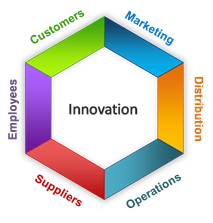 Creating a culture of innovation is by itself a huge change! It is not that change follows innovation, but change is required to create this and a mind-set. As it is quite often said, “managing innovation is about managing change” wherein change is injected into organizations by innovation flows across the whole organization’s ecosystem, be it Customers, Marketing, Distribution, Operations, Suppliers or Employees.
Creating a culture of innovation is by itself a huge change! It is not that change follows innovation, but change is required to create this and a mind-set. As it is quite often said, “managing innovation is about managing change” wherein change is injected into organizations by innovation flows across the whole organization’s ecosystem, be it Customers, Marketing, Distribution, Operations, Suppliers or Employees.
Innovations can be classified into three categories – incremental innovations (those which deliver incremental value), sustaining innovations (that are substantive and help sustain the growth of the existing business) and disruptive innovations (that quietly disrupt the existing business, serving low end or new markets to start with).
The Innovators maintain a laser focus on outcomes, avoid getting caught in the activity trap and proactively expand the pie to make an impact!
Innovation & Change
Innovation and Change share a common DNA! And, innovation exists to bring about a change and is a subset of change. The change dynamics of innovation is very different – internally, externally, technically and organizationally. As a leader, one has to nurture an idea through the various phases – from idea generation to commercialization.
Innovative organizations have proven that it is clearly about mind-set, thinking and culture, not just about processes, policies or problems. Harvard Business Review published study on how mind-set plays a pivotal role in innovation “as a robust framework that can be applied to individual as well as organizational level: they see and act on opportunities, use ‘and’ thinking to resolve tough dilemmas, and employ their resourcefulness to power through obstacles. The Innovators maintain a laser focus on outcomes, avoid getting caught in the activity trap and proactively expand the pie to make an impact”.
Business Thinking vs. Innovation Thinking
In all the four dimensions of AIDE, thinking clearly precedes action. It is many times true for Innovation. In fact, the thinking is also differentiated between Business Thinking and Innovation Thinking. The Center for Creative Leadership, USA published the results of a research study on ‘Becoming a Leader who Fosters Innovation’ and clearly distinguished how the VUCA world can be addressed through innovation, as per the table shared:
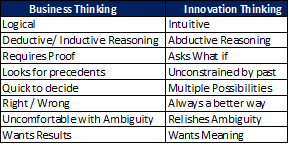 The ‘and thinking’ works here as well i.e. in managing the tension between these two seeming opposites. It is not about discarding the business thinking. It’s about acknowledging that both co-exist and that productive new products and services will result from finding the delicate balance between the two approaches.
The ‘and thinking’ works here as well i.e. in managing the tension between these two seeming opposites. It is not about discarding the business thinking. It’s about acknowledging that both co-exist and that productive new products and services will result from finding the delicate balance between the two approaches.
As the study reveals, “It’s also about the ability to switch between these two modes of thinking in order to implement creative ideas and turn them into innovations.
Leaders and organizations that do so will find a powerful antidote to complexity and an engine that can help them thrive—even during uncertain times.”
Innovation & GBS
There is a general belief that Innovation can happen more in business and not so much in global business services and operations. On top of this, sometimes there is a reference, if at all, innovation is more in front office operations than back office. Both are myths that have been bust. Innovation in the global support operations of businesses is often one of the critical levers most companies use for gaining speed and efficiency, to adapt to the changing environment.
Innovation in GBS happens in many ways: relentless pursuit of ‘cost elimination’, new avenues of increasing productivity or sources of revenue, full value chain of data-information-knowledge-insights-innovation to be fully exploited, to name a few.
It is important for the GBS or SSC teams to realize that they can deliver on innovation if only there is a clear focus on this area. The eSourcing Capability Model emphasizes innovation as a Level 4 practice and has several best practices outlined for enabling this mind-set, thinking, actions and outcomes. The power of Operational innovation needs to be fully understood or appreciated by GBS to ensure that they deliver on value creation besides cost arbitrage.
Disruption
Disruption has really assumed greater importance as a Tool set for Companies as the business environment discovered the VUCA world. This has opened newer opportunities for the business which did not seem to exist earlier.
While the term ‘disruption’ has been used more frequently in the last five years, it is similar to Creative Destruction (CD), which has been in business vocabulary for over 6 decades. The term disruption in the current context does not connote anything negative; on the contrary, it is a ‘process’ to produce positive outcomes to the industry, society or economy, and hence, is referred to as ‘Disruptive Innovation’ to convey the positive impact. Not all innovations are disruptive.
Disruptive innovations generally tend to be produced by outsiders! The business environment of market leaders does not allow them to pursue disruption when they first arise, because they are not profitable enough at first and because their development can take scarce resources away from sustaining innovations which are needed to compete against current competition. Increasingly, these take the nature of a ‘start up’, as these firms are more agile to identify opportunities and convert the ideas into business value propositions very quickly.
Disruptive innovations generally tend to be produced by outsiders! … It is easiest to think outside the box, when you are from outside the box
Think Outside the Box!
There is a quote saying, “It is easiest to think outside the box, when you are from outside the box”. Outsiders often come up with the best innovations – and mostly disruptive in nature – because they have no ties to the status quo. When it succeeds, it becomes a successful start- up.
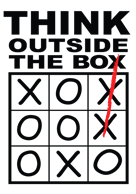 Some of the solid examples are social media, shared economy, streaming music/ video, book publishing, mobile camera, ecommerce, car sharing, VoIP, WhatsApp, to quote a known few. But when outsiders walk into established organizations, they often have difficult time effecting real change, because they are outsiders! Today, several large organizations profess that they have collaborative partnerships with start-up ecosystem to activate innovation, but as one senior leader observed,” We say we like to bring in outsiders with fresh ideas, but when they share them, we explain that’s not the way we do it here”. The insiders’ know-how & their buy-in are required to get them implemented.
Some of the solid examples are social media, shared economy, streaming music/ video, book publishing, mobile camera, ecommerce, car sharing, VoIP, WhatsApp, to quote a known few. But when outsiders walk into established organizations, they often have difficult time effecting real change, because they are outsiders! Today, several large organizations profess that they have collaborative partnerships with start-up ecosystem to activate innovation, but as one senior leader observed,” We say we like to bring in outsiders with fresh ideas, but when they share them, we explain that’s not the way we do it here”. The insiders’ know-how & their buy-in are required to get them implemented.
Disruptive Thinking
All innovations are not disruptive, but that does not mean innovations are, otherwise, incremental. Quite often, successful companies operating in mature industries spend large sums of money to identify Improvements and incremental innovations, to the extent that they reach the end of the path, with no option but to close down. Kodak is the best example to quote.
 Hence, ‘thinking the unthinkable’ is the essential ingredient to survival and growth in this VUCA world i.e. significant changes to the way you think about the competition and the business you are in. Little tweaks are irrelevant; it is a way of thinking that surprises market again competition and the business you are in. Little tweaks are irrelevant; it is a way of thinking that surprises market again and again, with exciting, unexpected solutions. A way of thinking that turns customer expectations upside down and takes an industry to the next generation is what is called ‘disruptive thinking’.
Hence, ‘thinking the unthinkable’ is the essential ingredient to survival and growth in this VUCA world i.e. significant changes to the way you think about the competition and the business you are in. Little tweaks are irrelevant; it is a way of thinking that surprises market again competition and the business you are in. Little tweaks are irrelevant; it is a way of thinking that surprises market again and again, with exciting, unexpected solutions. A way of thinking that turns customer expectations upside down and takes an industry to the next generation is what is called ‘disruptive thinking’.
Disruptive Change
The phrase ‘disruptive’ is associated with the notion of disruptive technology, as outlined in the book The Innovator’s Dilemma, by Clayton Christensen. In his book, he observes that disruptive technologies often enter at the bottom of the market, where established companies ignore them. Then they grow in influence and surpass the old systems. However, steadily, disruptive thinking is surely not limited to technologies, but more about ‘disruptive change’.
The way of thinking of a start-up can be learned and applied as effectively by large organizations and industry majors, as long as there is an enabling mind-set in the organization. Disruptive thinking is translated as a skill set through disruptive design or design thinking. Most of the time, the disruptive innovation process starts off pretty well, but inevitably lose their way and motivation, and forget all about ‘creative destruction’ as was started. As a result, instead of stimulating innovation, they end up stifling it.
Disruptors often build business models that are very different from those of existing industry incumbents. The best examples are both iPhone of Apple today and Microsoft of the 1980s for the PC Software! IBM partnered with Microsoft to launch the PCs. Having said, the Industry Majors need not over react to dismantle their still profitable business. Instead, they should continue to strengthen their relationships with core customers by investing in sustaining innovations.
Today’s Excellence is Tomorrow’s Mediocrity
Disruptive Innovation & GBS
As we highlighted earlier, Off-shoring was a disruptive innovation in mid 1990s, initially by In- house centers, followed by BPO Majors. KPOs, new structuring models like BOT by Aviva or Virtual Captives by Wells Fargo – all served to expand the disruption. Over the years, more disruptions were caused by either the new IT Tools/systems developed to support the business services domain or by adopting manufacturing techniques like Shift working, Six Sigma, Lean, TQM (TPQA) etc., These have enabled decreased cycle time, improved throughput, flexibility and scalability, improved accuracy, detailed data capture with controls, etc.
Several of the Reengineering, Transformation and Value Creation initiatives have been pursued as operational innovations, with a few being disruptive. Today is the age of RPA, the Robotics Process Automation, and along with IA (Intelligent Automation) as part of the Service Delivery Automation (SDA) gaining a lot of ground and becoming the order.
Excellence
In the AIDE world, Excellence, by far is the one that always existed for centuries and, will continue to exist for all times to come! It is more than just thinking - it is a philosophy, a Value system and even the outcome. The AIDE model is incomplete without this time tested and proven approach of Excellence to address the challenges of the VUCA world.
Great thinkers have attempted describe what Excellence is. Excellence is not perfectionism. Rather, Excellence is a journey through an ever changing landscape of new possibilities and methods. It is the best result that can be produced at a particular moment in time. Therefore, Excellence is something that can be achieved. But it can also be quickly lost as well. In a nutshell, “Today’s Excellence is Tomorrow’s Mediocrity.” More recently, John Gardner observed that “Excellence is doing ordinary things extraordinarily well.” Thomas Peters really nailed it when he observed that “Excellent firms don’t believe in excellence – only in constant improvement and constant change.” Any business which is not striving to be more excellent will soon find itself obsolete or out-manoeuvred by its competition (like Kodak or Polaroid).
Excellence is All Encompassing
Excellence in Business means constantly monitoring what is new in the marketplace of ideas. It means being open to putting those new ideas to work with your existing products and services. It means encouraging associates to come up with new ideas or suggestions for making products more relevant and efficient. The worst thing any business can do is become defensive and protective of the products and processes that are currently creating their income. Or, believe that they will remain ‘excellent’ for ever. What was excellent yesterday, may not be good enough today and may become out-dated tomorrow. To continue to survive, an excellent business must become its own competitor at some level within itself. It must encourage the development of products and services that, a first glance, seem to be against its best interests.
Excellence & Best Practices
Best Practices, Next Practices and Benchmarking, all constantly help organizations to the stay the course of excellence, and reaffirms their success and value. Global business services organizations will benefit by utilizing select tools and models that are applicable to their space. For instance, like the CMM for Software Development, eSCM is a great benchmark for best practices for Shared Service Centres as well as BPOs to compare themselves against the Levels 1 to 5 and calibrate their current state of capabilities and work to sustain value and excellence. In fact, the model has an in-built mechanism that Level 5 can be achieved, only when Level 4 is sustained for 2 years.
To continue to survive, an excellent business must become its own competitor at some level within itself. It must encourage the development of products and services that, at first glance, seem to be against its best interests.
In summary
 VUCA world is real and will only get more and more and intense, as the global economy becomes a global village. BRICS is already getting stretched at its seams, with India just recovering its momentum in the last 12-18 months. Given that this situation will only get worse, it is imperative for organizations to think and do things differently – this is where the AIDE Model comes into play!
VUCA world is real and will only get more and more and intense, as the global economy becomes a global village. BRICS is already getting stretched at its seams, with India just recovering its momentum in the last 12-18 months. Given that this situation will only get worse, it is imperative for organizations to think and do things differently – this is where the AIDE Model comes into play!
AIDE Models recognizes that it is best to go beyond the external forces that we cannot control and focus on actions that we can control, execute and influence.
It has four key drivers to be successful – Mind-set, Thinking, Practice and Execution towards AIDE! Rethink the ways by which you will change the mind-set to direct the organization and people to become ‘agile’ channelize their energies through positive thinking and culture of ‘innovation’, engage the organization and cultivate practices to cause ‘disruptive’ changes, and finally execute the plans and changes to achieve outcomes of ‘excellence’.
AIDE is your ‘call to order’ to deal with the VUCA world.
ABOUT THE AUTHOR

Ravi S Ramakrishnan is a seasoned business and people leader with invaluable experience of 35 years in finance, business and business process areas. He was instrumental in setting up the pioneering global offshoring operations at American Express. Having held leadership positions earlier in Hindustan Unilever, Murugappa Group and Eicher with CXO level responsibilities, Ravi is recognized as a thought leader in off shoring and business process domains. He uniquely combines exposure to multiple sectors of Indian and global corporations, and drives the vision and strategies for growth of RvaluE in the niche area of business process services through a team of professionals. Ravi is a Chartered & Cost Accountant and a Company Secretary.




